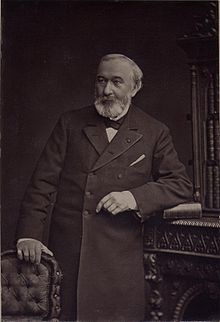Joseph Poelaert
Joseph Poelaert | |
|---|---|
 | |
| Born | 21 March 1817 Brussels, Belgium |
| Died | 3 November 1879 (aged 62) Brussels, Belgium |
| Nationality | Belgian |
| Occupation | Architect |
| Buildings | Palace of Justice of Brussels Church of Our Lady of Laeken |
Joseph Poelaert (21 March 1817 – 3 November 1879) was a Belgian architect. He was entrusted with important projects in Brussels, such as Saint Catherine's Church, the Church of Our Lady of Laeken, the Congress Column, the Royal Theatre of la Monnaie and above all, the Palace of Justice. He was also the great-uncle of the architect Henri Van Dievoet.
Life
[edit]Early life
[edit]Joseph Poelaert was born in Brussels on 21 March 1817. His father was Philip Poelaert (1790–1875), a former architecture student at the Royal Academy of Fine Arts in Brussels. The young Poelaert also trained there under Tilman-François Suys, and then in Paris under Louis Visconti and Jean-Nicolas Huyot.
He first came to attention with his winning competition entry for the Congress Column in 1849. He was made city architect of Brussels in 1856.
Palace of Justice
[edit]Poelaert's most significant commission was the colossal Palace of Justice of Brussels, the largest single building constructed in the 19th century and even copied in smaller scale at the Palace of Justice in Lima, Peru.[1]
For the Palace of Justice's construction, a section of the Marolles/Marollen neighbourhood was demolished. Poelaert himself resided in the Marolles, only a few hundred metres from the building, on the Rue des Minimes/Minimenstraat, in a house adjoining his vast offices and workshops and communicating with them.[2][3] It is thus unlikely he saw himself as ruining the neighbourhood. Nonetheless, many angry citizens personally blamed Poelaert for the forced relocations, and the expression schieven architect (meaning "shameful architect") became one of the most serious insults in the dialect of the Marolles.[4]
Family
[edit]Marriage
[edit]At the age of 42, on 25 August 1859 in Brussels, Poelaert married Léonie Toussaint, aged 19, born in Ixelles on 30 March 1840, and died in Brussels on 23 July 1912, daughter of Joseph Ferdinand Toussaint, notary public in Brussels and former Member of Parliament and of Philippine Anne Catherine Joséphine Kuhne. She was also the sister of Fritz Toussaint, a painter, and of Jules Toussaint.[5]
Later life and death
[edit]Poelaert retired in 1874 to his villa at the Grande Grille, on 363, avenue de la Reine/Koninginnelaan, in the then-rural village of Laeken. He died on 3 November 1879[6] and was buried in Laeken Cemetery under a miniature version of his Palace of Justice.
Works
[edit]- 1850–1859: Congress Column in Brussels
- 1854–1874: Saint Catherine's Church in Brussels
- 1854–1909: Church of Our Lady of Laeken in Brussels, site of the Royal Crypt of the Belgian royal family
- 1855–1857: Restoration of the Royal Theatre of La Monnaie in Brussels, after the fire of 1855
- 1866–1883: Palace of Justice in Brussels
-
Pedestal of the Congress Column, Brussels (1850–1859)
-
Royal Theatre of La Monnaie, Brussels (1855–1857)
-
Palace of Justice, Brussels (1866–1883)
-
Bust of Poelaert at the Palace of Justice
-
Poelaert's tomb in Laeken Cemetery, Brussels
-
Coat of arms of the Poelaert family
References
[edit]Notes
[edit]- ^ Paucescu, Alexandra (4 November 2022). "A PALACE FOR JUSTICE – A never-ending Belgian story". Europe Diplomatic Magazine.
- ^ Vandendaele 1980, p. 166.
- ^ Mardaga 1994, p. 466.
- ^ "Palais de Justice" (in French). Belgian federal building registry. 29 September 2009. Archived from the original on 24 February 2011. Retrieved 12 August 2009.
- ^ MARCHAL, Edmond (1903). Biographie nationale de Belgique. Brussel.
{{cite book}}: CS1 maint: location missing publisher (link) - ^ "A PALACE FOR JUSTICE – A never-ending Belgian story". 4 November 2022.
Bibliography
[edit]- Vandendaele, Richard (1980). Poelaert et son temps (exhibition catalogue) (in French). Brussels: Crédit Communal de Belgique.
- Mardaga, Pierre, ed. (1994). Le Patrimoine monumental de la Belgique: Bruxelles (PDF) (in French). Vol. 1C: Pentagone N-Z. Liège.
{{cite book}}: CS1 maint: location missing publisher (link)
External links
[edit] Media related to Joseph Poelaert at Wikimedia Commons
Media related to Joseph Poelaert at Wikimedia Commons






